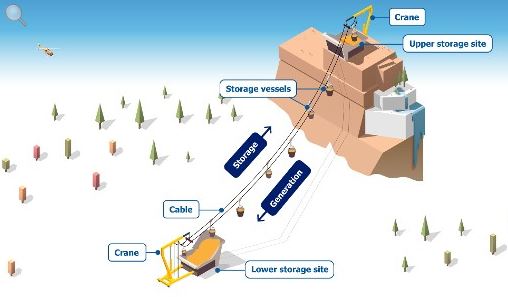

Mountain's? Full of Energy, Potentially. Image Courtesy: IIASA
While information is still awaited on the fate of the MNRE proposal for gravity storage based systems, a number of exciting options are coming out every few months.
But first, a quick word on gravity storage itself. Gravity based energy storage has been proposed as a potential solution with unique advantages of short response time and flexibility. In such systems, electricity is used to lift mass to higher elevation thereby storing potential energy and lowering this mass discharges the energy which can again be converted to electricity. Globally, a number of entities are working in this segment.
In fact, Energy Vault, a firm in the segment had also announced a venture with Tata Power back in 2018, for a similar project. We could not see any update on that yet.
Now, researchers at IIASA, (International Institute of Applied Systems analysis) are keen to prove that we can use mountains as gigantic batteries for long-term energy storage. A study by Julian Huntis of IIASA and his colleagues on storing energy in locations that have less energy demand and variable weather conditions that affect renewable energy sources led them to this direction. The team looked at places like small islands and remote places that would need less than 20 megawatts of capacity for energy storage and proposed a way to use mountains to accomplish the task.
Hunt and his team want to use a system dubbed Mountain Gravity Energy Storage (or MGES). MGES employes cranes positioned on the edge of a steep mountain to move sand (or gravel) from a storage site at the bottom to a storage site at the top. Like in a ski-lift, a motor/generator would transport the storage vessels, storing potential energy. Electricity is generated when the sand is lowered back from the upper site.
How much energy is created? The system takes advantage of gravity, with the energy output being proportional to the sand’s mass, gravity and the height of the mountain. Some energy would be lost due in the loading and unloading process.
Hydropower can also be employed from any kind of mountainous water source, like river streams. When it’s available, water would be used to fill storage containers instead of sand or gravel, generating electricity in that fashion. Utilizing the mountain, hydropower can be invoked from any height of the system, making it more flexible than usual hydropower, explains the press release from IIASA.
There are specific advantages to using sand, however, as Hunt explained:
“One of the benefits of this system is that sand is cheap and, unlike water, it does not evaporate – so you never lose potential energy and it can be reused innumerable times,” said Hunt. “This makes it particularly interesting for dry regions.”
A really interesting proposition, that one hopes get tried in India too, sooner than later.
In a significant move toward advancing green energy and industrial growth in the state, Himachal…
Golabl chemical conglomerate BASF has announced that its now offering the world’s first biomass-balanced polyethersulfone…
In a crucial stint to bolster the biogas sector and sustainable dairying in the country,…
TotalEnergies SE has received approval to proceed with its Middlebrook solar and battery project in…
Andhra Pradesh Chief Minister Chandrababu Naidu has inaugurated the Rs 1,000-crore green hydrogen plant of…
The BITS Pilani has developed an innovative solution for managing landfill leachate, domestic septage, and…